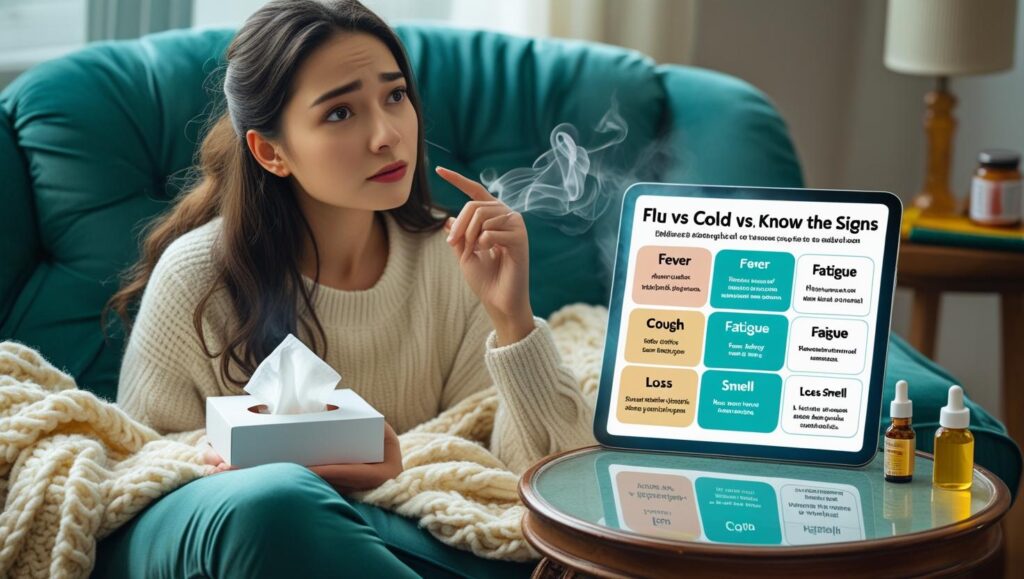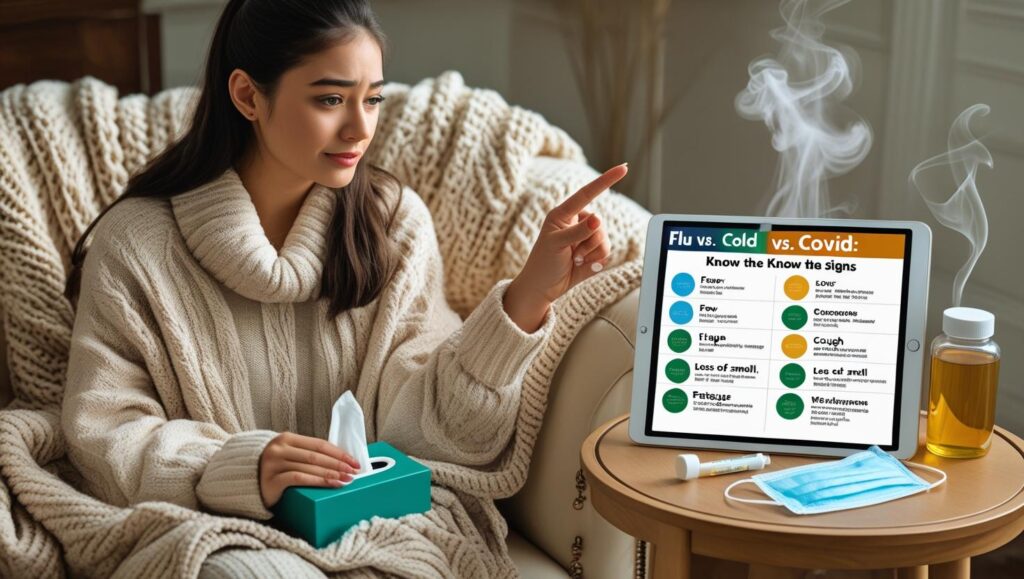Over the past few years, the lines between a common cold, the flu, and COVID-19 have blurred in the minds of many people. With all three illnesses capable of causing respiratory symptoms, it’s easy to confuse one for another. However, distinguishing between these conditions is crucial for proper treatment, preventing the spread, and ensuring faster recovery.
In this article, we’ll break down the symptoms of the flu, cold, and COVID-19, how they overlap, and what makes each one unique. By understanding the distinctions, you’ll be better equipped to take care of yourself and others when symptoms strike.

Why It’s Important to Tell the Difference
All three illnesses—influenza (flu), the common cold, and COVID-19—are caused by different viruses. While they share many similar signs, some subtle (and not-so-subtle) differences can help guide decisions like when to isolate, when to seek medical care, and what treatments may help.
Understanding the symptoms also helps:
- Prevent unnecessary panic
- Identify severe illness early
- Take appropriate measures to protect vulnerable people (children, elderly, or those with chronic illnesses)
Let’s break down each one.
Common Cold: Mild But Inconvenient
What Causes It?
The common cold is caused by several different viruses, most commonly rhinoviruses. It’s the most frequent respiratory illness in both adults and children.
Common Symptoms
- Runny or stuffy nose
- Sneezing
- Sore throat
- Mild to moderate cough
- Mild headache
- Mild fatigue
- Watery eyes
Symptom Onset
- Gradual – symptoms usually appear slowly over 1–3 days.
Key Features
- Usually no fever (especially in adults)
- Symptoms stay in the upper respiratory tract (nose, throat)
- Symptoms peak within 2–3 days and usually resolve in 7–10 days
- Not typically associated with serious complications
When to See a Doctor
See a healthcare provider if:
- Symptoms persist beyond 10 days
- You develop high fever
- Shortness of breath or chest pain occurs
Influenza (Flu): Strong and Sudden
What Causes It?
The flu is caused by influenza viruses, usually Influenza A or B. It tends to be seasonal, peaking in fall and winter.
Common Symptoms
- Fever or chills
- Body and muscle aches
- Fatigue (often severe)
- Dry cough
- Sore throat
- Headache
- Runny or stuffy nose
Symptom Onset
- Sudden – symptoms often hit hard and fast, usually within a few hours.
Key Features
- Fever is common and high (often 100°F to 104°F)
- More systemic symptoms like body aches and fatigue
- You may feel completely wiped out for days
- Lasts about 5–7 days, but fatigue can linger for weeks
Complications
The flu can lead to:
- Pneumonia
- Bronchitis
- Ear and sinus infections
- Exacerbation of chronic conditions like asthma or heart failure
When to See a Doctor
Seek care if:
- You’re in a high-risk group (young children, elderly, pregnant people, chronic illness)
- Symptoms worsen after initial improvement
- You have trouble breathing or chest pain

COVID-19: The New Player in Town
What Causes It?
COVID-19 is caused by the novel coronavirus SARS-CoV-2, first identified in late 2019. It’s more infectious than the cold or flu and has a broader range of symptoms.
Common Symptoms (Most Frequent)
- Fever or chills
- Dry cough
- Shortness of breath
- Fatigue
- Loss of taste or smell
- Muscle or body aches
- Sore throat
- Congestion or runny nose
- Headache
- Nausea or vomiting
- Diarrhea
Symptom Onset
- Varies – typically 2–14 days after exposure. Some people are asymptomatic.
Key Features
- Loss of taste or smell is a hallmark symptom (especially in earlier variants)
- More gastrointestinal symptoms than cold or flu
- Higher risk of serious complications, especially for the elderly and immunocompromised
- Can cause long COVID – lingering symptoms for weeks or months
When to See a Doctor
Urgent medical attention is needed for:
- Trouble breathing
- Persistent chest pain
- New confusion
- Inability to wake or stay awake
- Bluish lips or face
Testing is Critical
Because COVID-19 symptoms can mimic both flu and cold, testing is the only reliable way to confirm it. Home antigen tests or PCR tests are widely available.
Comparing Symptoms Side-by-Side
Here’s a quick reference chart to help compare the three:
| Symptom | Cold | Flu | COVID-19 |
|---|---|---|---|
| Fever | Rare | Common (high) | Common |
| Cough | Mild/moderate | Common (dry) | Common (dry or wet) |
| Fatigue | Mild | Moderate–severe | Moderate–severe |
| Body aches | Rare | Common | Common |
| Runny/stuffy nose | Common | Sometimes | Common |
| Sore throat | Common | Sometimes | Common |
| Sneezing | Common | Rare | Sometimes |
| Shortness of breath | Rare | Rare | Common (in severe cases) |
| Loss of taste/smell | Rare | Rare | Often |
| Headache | Rare | Common | Common |
| Gastro symptoms | Rare | Sometimes (kids) | Sometimes |
| Onset speed | Gradual | Sudden | Varies (2–14 days) |
When to Get Tested

Because symptoms overlap, the only way to be certain is testing. Get tested if:
- You have COVID-19 symptoms
- You’ve been exposed to someone with COVID
- You are high-risk and develop respiratory symptoms
- You need a diagnosis for treatment eligibility (e.g., antivirals)
Many pharmacies and clinics offer rapid antigen tests or PCR testing. Home test kits are also widely available.
How to Manage Symptoms at Home
Regardless of whether you have the flu, cold, or COVID-19, treatment for mild cases usually includes:
- Rest: Essential for recovery
- Hydration: Drink plenty of fluids
- Fever reducers: Use acetaminophen or ibuprofen for fever and aches
- Cough relief: Cough drops, humidifiers, or over-the-counter cough medicine
- Isolation: Stay away from others if you suspect flu or COVID
Always consult a healthcare provider before starting new medications, especially for children, pregnant individuals, or those with chronic conditions.
Prevention Tips
Preventing respiratory illness is often about consistent, healthy habits. Here are some ways to reduce your risk:
- Wash hands frequently
- Avoid close contact with sick individuals
- Wear a mask in crowded or indoor spaces during peak illness season
- Get vaccinated:
- Annual flu shot
- COVID-19 vaccines and boosters
- Cover coughs and sneezes
- Stay home when you’re sick
Final Thoughts
Knowing the differences between the cold, flu, and COVID-19 can empower you to make informed decisions for yourself and your family. While these illnesses can present with overlapping symptoms, key distinctions like onset speed, fever intensity, and loss of taste/smell can help point you in the right direction.
Still, symptoms alone may not always tell the full story. When in doubt, get tested and consult with a healthcare provider.
Stay healthy—and when in doubt, rest it out!
Have questions or personal experiences with these illnesses? Share in the comments below! And don’t forget to follow for more practical health insights.
![]()






